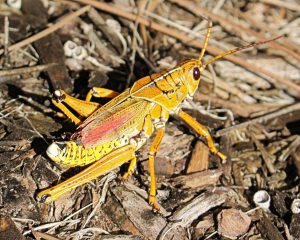
UF/IFAS Extension had a booth at the recent Public Works & Community Outreach Day held at the Fairgrounds on June 10th. Here we displayed our programs and shared information on what we do as an organization in the community. I brought along several cases of pinned insects to show the public the array of these critters in our area. It was a fun, family-oriented event and the one insect that most visitors to the booth wanted to talk about was the Eastern Lubber Grasshopper. That can only mean that 2023 is going to be a bumper year for lubbers in our area!
In February and early March, some residents of Charlotte County began seeing small, dark-colored grasshoppers in their landscapes. These baby lubbers emerged earlier from the ground as they hatched out from last year’s eggs. Young grasshoppers are called nymphs. Nymphs are black and yellow striped, immature grasshoppers that look exactly like small adults except that they lack wings, are a different color, and cannot reproduce at this stage. To make room for their ever-expanding size, a nymph sheds its skin (molts) and gets a little bigger every fifteen to twenty days. At the last molting, they become full-fledged adults – that is what we are seeing now. The adults are huge and yellow in color with black dots and red coloration on the hind wings. Females are bigger than males and can get up to three and one-half inches long. The adults also have a pair of short, useless wings. Populations of this giant, slow grasshopper vary from place to place in Charlotte County.

In addition to their large size and striking coloration, lubbers also have some other defenses to protect themselves. The lubber grasshopper has toxic properties that keep various animals from eating them. These grasshoppers can produce a frothy spray from their midsection which can irritate potential predators. As such, lubbers are not normally consumed by predators except by a bird called the loggerhead shrike. These birds capture and impale the lubbers on thorns which allows the toxins to degrade in a few days.
While lubbers are large, they tend to eat less than some of their smaller relatives as far as consuming landscape plants. This may be of little comfort to those whose landscape is eventually covered with these large insects! Their favorite plants include amaryllis, Amazon lily, crinum, and related plants, as well as oleander, certain jatropha, the Mexican petunia, and lantana. Some weeds are not sparred and may end-up on the lubber’s menu including chamber bitter and Florida beggarweed. Lubbers have several invertebrate natural enemies including parasitic flies and nematodes which work behind the scenes to help suppress these pests. As lubbers are large targets and move slowly, non-chemical control via hand-picking, can help reduce numbers. Keep in mind that the smaller nymph grasshoppers are easier to control than adults. There are some chemical options including permethrin and Spinosad applied as per label directions, but often an overwhelming infestation cannot be easily stopped. Fortunately, while the largest number of adult lubbers will be observed in July and August, only a single generation occurs per year.
Lubber grasshoppers are not everywhere in Charlotte County, but when present can be numerous. Monitor populations and take any practical actions you can to suppress this potential pest to manageable levels. For more information on all types of Florida insect issues, or to ask a question, you can also call the Master Gardener Volunteer Helpdesk on Mondays, Wednesdays, and Fridays from 1 to 4 pm at 764-4340 for gardening help and insight into their role as an Extension volunteer. Ralph E. Mitchell is the Director/Horticulture Agent for UF/IFAS Extension – Charlotte County. He can be reached at 941-764-4344 or ralph.mitchell@charlottecountyfl.gov . Connect with us on social media. Like us on Facebook @CharlotteCountyExtension and follow us on Instagram @ifascharco.
Resource:
Capinera J. L. & Scherer, C. W. (2021) Eastern Lubber Grasshopper, Romalea microptera . The University of Florida Extension Service, IFAS.
 1
1
